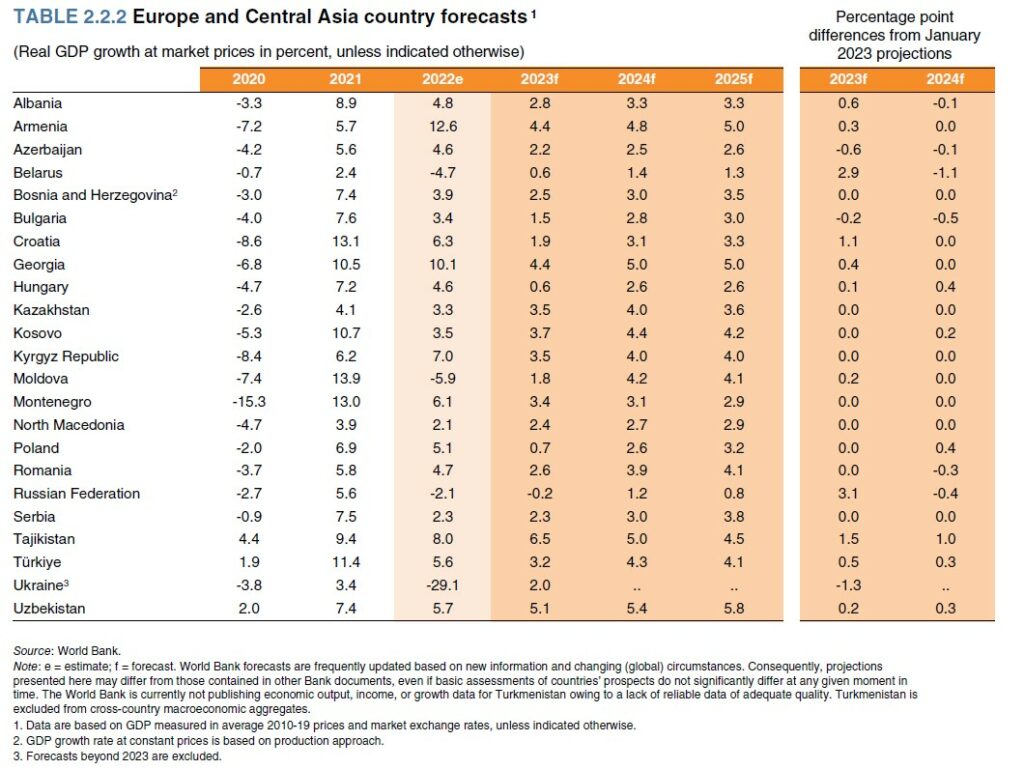GDP growth in Uzbekistan this year, according to the new forecast of the World Bank, will be 5.1%. In January, the bank forecast growth of 4.9%.
The World Bank has published a regular report “Global Economic Prospects” (published twice a year – in January and June). It highlights current trends, risks and forecasts for the development of global, regional and national economies.
Growth in the Europe and Central Asia (ECA) region slowed sharply to 1.2 percent in 2022, the slowest of the six emerging market and developing economies (EMDE) regions of the world, according to the report. Even excluding Russia and Ukraine, growth in the ECA region declined to 4.8 percent in 2022.

The economic slowdown was almost universal across most of the region’s economies, reflecting the turmoil caused by the Russian invasion of Ukraine, declining business and consumer confidence, a surge in inflation, a marked tightening of monetary policy by government regulators, and disruptions in energy supplies.
In Eastern Europe, output fell by 20.2 percent, mostly in Ukraine. However, the reduction was also observed in the rest of the region. In Central Europe and the Western Balkans, which are more closely integrated into European Union (EU) global value chains, growth has slowed as a result of energy price spikes, energy supply disruptions and monetary tightening.
By contrast, growth in the South Caucasus and Turkey accelerated on the back of increased trade flows, as well as an influx of migrants and finance from Russia and Ukraine, factors that also contributed to growth in Central Asia. Rising world commodity prices softened the downturn in economic activity in commodity exporters, with the exception of Russia.
In the ECA region, especially in Turkey, inflation continues to be high. While nominal wage growth has generally lagged behind price growth, real wages in Eastern Europe fell by 3.3 percent in the first half of 2022. However, the countries of Central Asia and the South Caucasus are an exception to this rule.
Signs of a slowdown in annual inflation that have been observed recently in a number of ECA countries can be attributed to the effects of a high base, as well as lower energy prices from last year’s highs. However, core inflation remains elevated. To reduce above-target inflation, 17 central banks in the region increased key rates in 2022, and 6 central banks re-raised during the past months of 2023.
Forecast. In 2023, the ECA region is projected to experience a modest increase in economic growth to 1.4 percent. However, due to Russia’s invasion of Ukraine and its aftermath, growth prospects remain highly uncertain. Excluding Russia and Ukraine, the growth rate expected in the ECA region in 2023 is 2.4 percent, almost halving. The increase in the January forecast by 1.3 percentage points for the region as a whole is mainly due to the fact that the forecast for Russia was revised upwards.
Tajikistan and Uzbekistan are expected to show the highest GDP growth in 2023 among the 23 economies in the ECA region, at 6.5 percent and 5.1 percent, respectively. They are followed by Armenia and Georgia with 4.4 percent growth this year.
In 2024-2025, the region is expected to pick up its annual growth rate to 2.7 percent, supported by stronger external and domestic demand as the impact of recent economic shocks gradually eases, as well as the normalization of inflation and fiscal policy. Growth disparities across the region should narrow as inflows of migrants and capital from Russia decline and economic activity in the EU picks up.
The twin blows of the COVID-19 pandemic and the Russian invasion of Ukraine have had a significant impact on economic growth in the ECA region, which is expected to remain below potential over the next three years under the impact of tighter credit conditions and a gradual fiscal consolidation in many countries.
Risks. Risks to the regional outlook remain skewed to the downside, with the possibility of a more intense or prolonged conflict in Ukraine, a possible acceleration in inflation coupled with further tightening of monetary policy by government regulators, and financial sector turmoil.
A sharper (compared to forecast) slowdown in economic activity in the eurozone will also lead to further weakening of external demand for the countries of Central Europe and the Western Balkans.
In addition, this year the volume of remittances from Russian labor migrants may grow more slowly than expected, especially in the countries of Central Asia and the South Caucasus.
An escalation of the conflict in Ukraine could increase energy security risks as countries in the ECA region remain vulnerable to supply disruptions and dependence on Russia.
Downside risks also include increased geopolitical tensions elsewhere in the ECA region and increased displacement in the event of adverse weather events associated with climate change.
Download the World Economic Outlook report: https://bit.ly/GEPJune2023FullEN